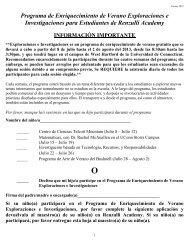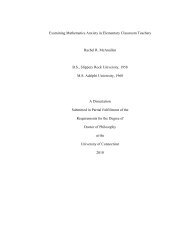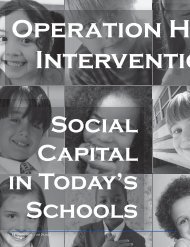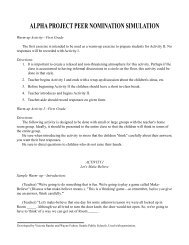Giftedness and High School Dropouts - Neag Center for Gifted ...
Giftedness and High School Dropouts - Neag Center for Gifted ...
Giftedness and High School Dropouts - Neag Center for Gifted ...
Create successful ePaper yourself
Turn your PDF publications into a flip-book with our unique Google optimized e-Paper software.
9<br />
Some research focused on racial issues. The South Dakota State Department of<br />
Education <strong>and</strong> Cultural Affairs (1993) reported that among 178 public school districts<br />
<strong>and</strong> 44 non-public schools, the dropout rate <strong>for</strong> American Indian students was highest<br />
(12.8%) compared with White students (1.5%). Studying eighth graders <strong>and</strong> high school<br />
students in Dade County, Stephenson (1985) found that almost 60% of dropping out took<br />
place during the first 2 years of high school, <strong>and</strong> Blacks were more likely to drop out later<br />
than other ethnic groups. Nelson (1985) quoted the estimates from the National <strong>Center</strong><br />
<strong>for</strong> Education Statistics. According to those estimates, among the dropouts in 1982,<br />
Hispanics (18%) <strong>and</strong> Black students (17%) had higher dropout rates than White students.<br />
The Los Angeles Unified <strong>School</strong> District (Bernoff, 1981) also found that the proportions<br />
of Black <strong>and</strong> Hispanic dropouts were higher than their respective proportions of all high<br />
school students in their school districts. However, Lobosco (1992) found that after<br />
controlling <strong>for</strong> family background <strong>and</strong> other factors, Blacks were more likely to graduate<br />
from high school than Whites, Asians, or Hispanics. Similarly, the National <strong>Center</strong> <strong>for</strong><br />
Education Statistics (1993) report stated that the stereotype of the high school dropout<br />
being a Black male teenager is not true. According to the report, the proportion of Black<br />
male students leaving school in 1992 was lower than White males (3.3%), White females<br />
(4%), Black females (6.7%), Hispanic males (7.6%), <strong>and</strong> Hispanic females (9%). Whites<br />
account <strong>for</strong> 59% of all dropouts, <strong>and</strong> students from middle-income families account <strong>for</strong><br />
57%.<br />
Personal problems were also considered as reasons <strong>for</strong> dropping out of school.<br />
Bempechat (1989) stated that drug <strong>and</strong> alcohol abuse <strong>and</strong> pregnancy are related to<br />
dropping out. She also stressed that some factors such as parental drug use, peer<br />
influence, <strong>and</strong> stress might lead to drug use. LaChance (1988) reported that<br />
approximately 17% of 13-17 year old youths have used marijuana, <strong>and</strong> 67% of them have<br />
experimented with drugs be<strong>for</strong>e graduating from high school. Bempechat (1989) also<br />
studied the problem of teenage pregnancy. She reported that teenagers in the U.S.<br />
typically first experience sexual activity at 16 years old. The average age of first<br />
intercourse becomes much lower in some cities, especially when disadvantaged minority<br />
teenagers are involved. Teenage pregnancy is strongly associated with poor academic<br />
achievement, family influences, <strong>and</strong> dropout decision.<br />
Another significant factor related to students' dropout behavior is family<br />
background. Some researchers indicated that low levels of education <strong>and</strong> occupational<br />
status of parents were significantly related to the student's decision to drop out (Noth &<br />
O'Neil, 1981; Sadowski, 1987). The Wisconsin Department of Public Instruction<br />
(Naylor, 1989) reported that students whose parents have low expectations <strong>for</strong> their<br />
child's success, whose parents place little value on education, <strong>and</strong> whose family has a<br />
history of dropouts are likely to drop out. Self (1985) also indicated that many dropouts'<br />
parents had low educational achievement <strong>and</strong> had themselves dropped out of school.<br />
Grossnickle (1986) stated that home problems are common among dropouts. Similarly,<br />
Nelson (1985) stated that dropouts typically have family problems such as divorce, death,<br />
alcohol, drug, emotional, or physical abuse, <strong>and</strong> family members who dropped out of<br />
school. Sadowski (1987) concluded that the dropout's family was less solid, not much<br />
influenced by the father, participated little in the leisure activities, <strong>and</strong> communicated less
















